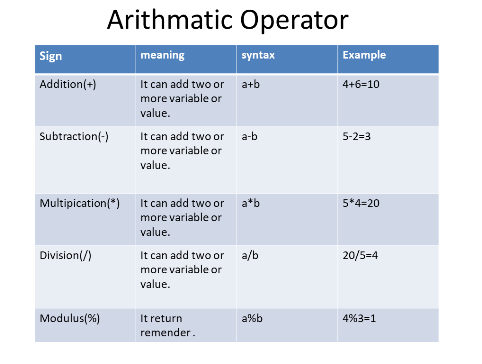Operators in Python
Operators are used to perform operations on variables and values.
- Arithmetic operators
- Assignment operators
- Relational Operators
- Logical operators
- Bitwise operators
Arithmetic operators
It is used to perform arithmetic operation like Addition,Subtraction,multiplication,division and modulus.
Types of arithmetic operators is given below:-

Assignment operators
The word Assignment is stand for 'assign'+'ment' means "assign value to some variable".the value of right side which have same datatype to left side.
Types of assignment operators is given below:-

Relational Operators
This operator is used in comparison of the values of two operands.means suppose we have two number x=12 and y=13 we can apply (>,<,<=,>=,==,!=) if we compare x<y,then it return 1,if x>y,then it return 0.
Types of Relational operators is given below:-

Logical Operators
When we combine two or more Condition and implement original condition then we are use logical operater
Types of Logical operators is given below:-

Bitwise Operators
In C programming languages there are 6 bitwise operators and
types of Bitwise operators and its function are:-
and(&)
The bitwise AND operator is denoted by single ampersand: &. While performing the bitwise AND operation is 1 if both the bits have the value as 1; otherwise, the result is always 0.
Example
#include<stdio.h>
int main()
{
int a=7,b=11;
printf("%d & %d=%d",a,b,a&b);
}
Output
11
or(|)
The bitwise OR operator is denoted by: |. While performing the bitwise OR operation is 1 if any one of the bits have the value as 1; otherwise, the result is always 0.
Example
#include<stdio.h>
int main()
{
int a=7,b=11;
printf("%d | %d=%d",a,b,a|b);
}
Output
15
bitwise not(~)
The bitwise NOT operator is denoted by: '~'. While performing the bitwise NOT operation is 1 if bit is 0; otherwise, the result is always 0.
Example
#include<stdio.h>
int main()
{
int a=7;
printf("~%d=%d",a,~a);
}
Output
~7=248
Right shift(>>)
The bitwise Right Shift operator is denoted by: '>';, and when two numbers, right shifts the bits of the first operand, the second operand decides the number of places to shift.
Example
#include<stdio.h>
int main()
{
int a=7;
printf("%d >>1=%d",a,a>>1);
}
Output
7>>1=5
Left shift(<<)
The bitwise Left shift operator is denoted by: <, and when two numbers, left shifts the bits of the first operand, the second operand decides the number of places to shift.
Example
#include<stdio.h>
int main()
{
int a=7;
printf("%d <<1=%d",a,a<<1);
}
Output
7<<1=22